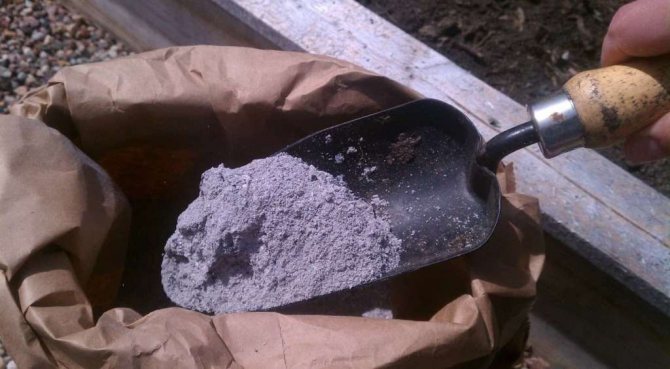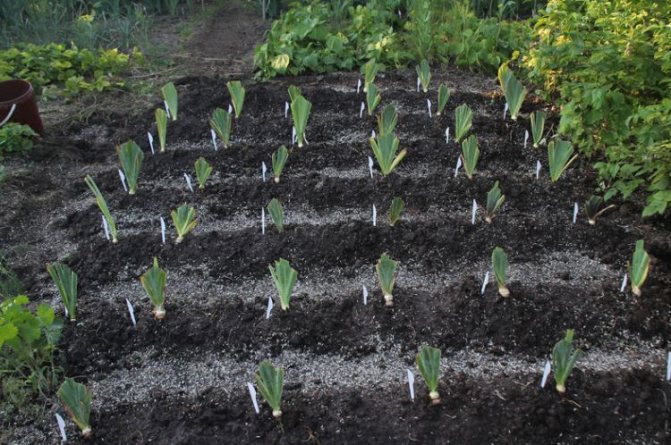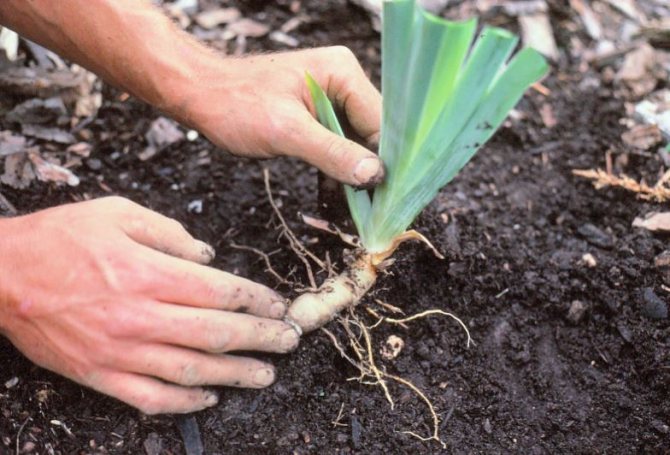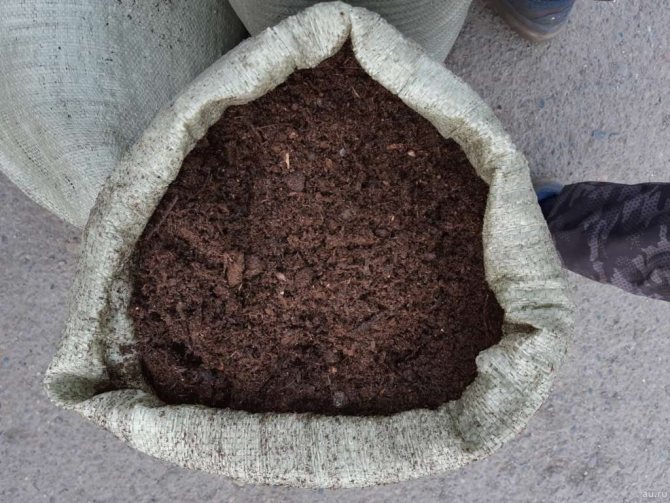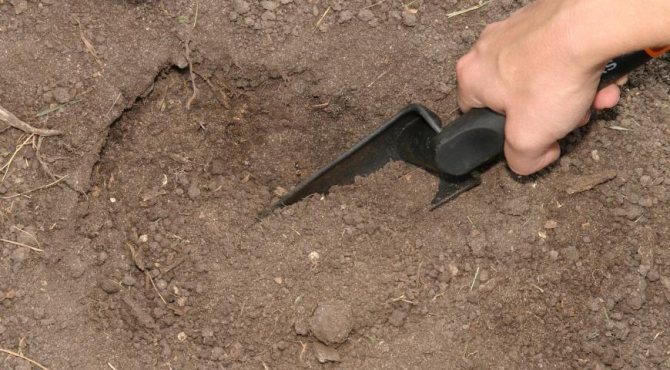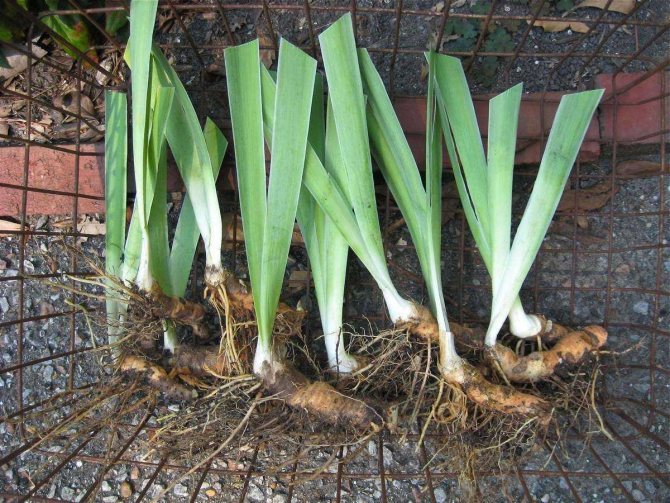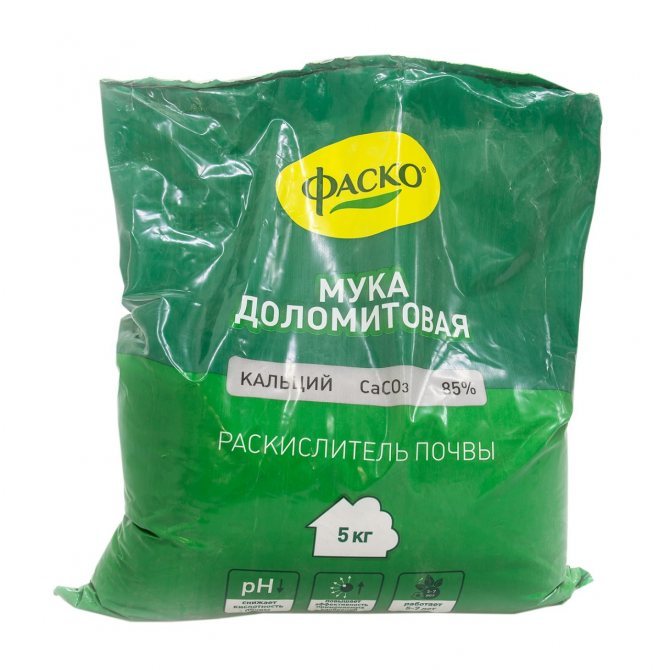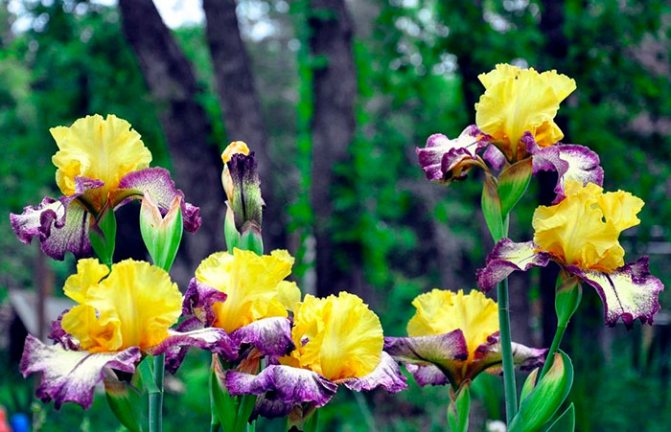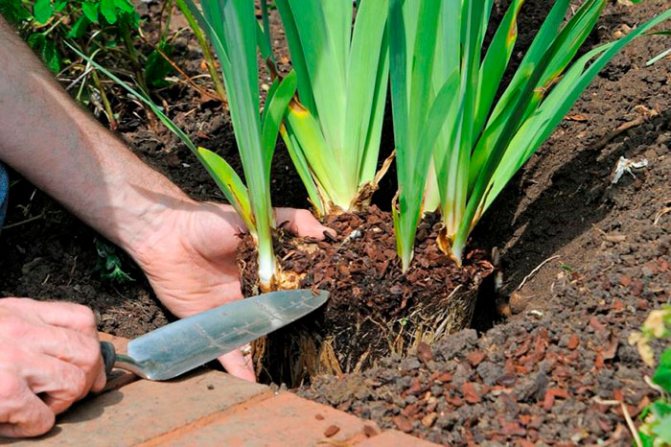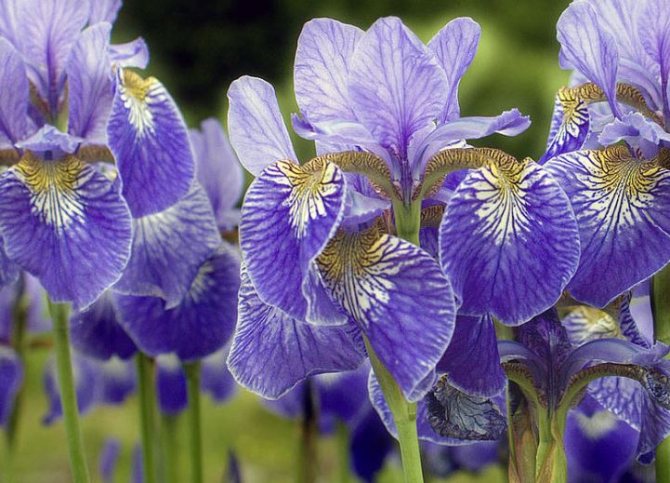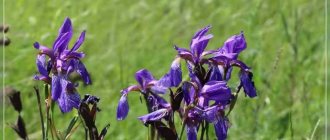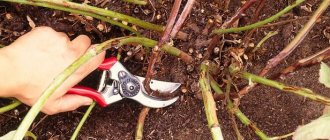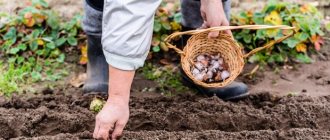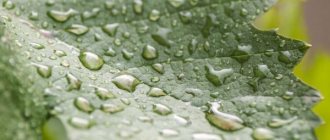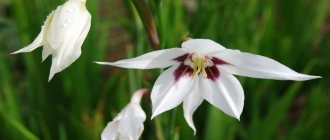Do-it-yourself beautiful and productive beds
Home ›Flowers› How to feed irises in spring before flowering
Irises are perennial plants, also called Iris and Cockerel. More than 800 species of this plant are known with flowers of various shapes and colors, with powerful rhizomes and bulbs.
Iris root has a slight violet scent and is called "violet root". Perfumers use the dried rhizome of the iris to obtain an essence that adds a floral-powdery note to the perfume composition.
Iris means rainbow in Greek. Indeed, in the garden, thickets of irises create a magnificent color scheme (pictured). Correctly selected varieties with different flowering periods allow you to enjoy the flowers of the iris throughout the summer.
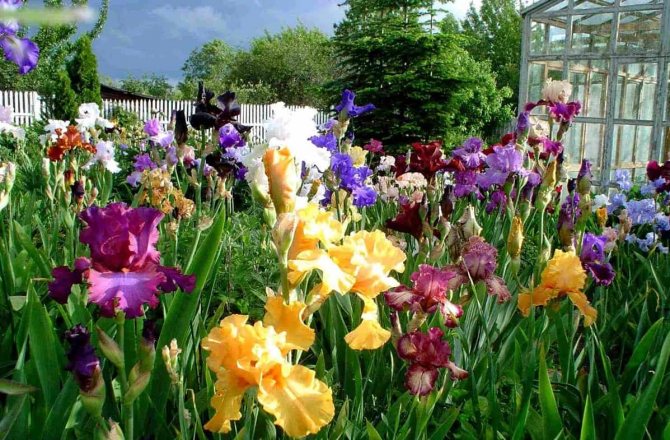
There is a variety of bulbous irises that looks like rhizomatous iris. There are some differences in agricultural practices of rhizome and bulbous species, but the principles of feeding are the same for them, plants are fertilized in early spring, during the period of bud formation and after flowering. In the article we will tell you how and what to feed irises so that they will delight us with lush flowering.
Landing in open ground
Iris bulbs are planted in the fall before the first frost or in the spring. It is recommended to plant rhizomes in spring or summer. To preserve irises before planting in the spring, it is necessary to thoroughly clean the planting material from the ground without damaging the surface of the bulbs or rhizomes. If damage is found during digging, or rot, the affected areas must be cleaned.
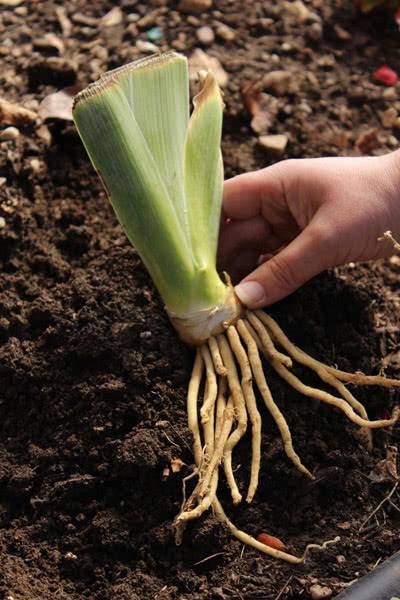

Before planting in the ground, the bulbs, rhizomes are thoroughly disinfected. Fans of sustainable gardening can use garlic, aloe juice. It is necessary to pour about ten crushed garlic with a liter of water, then soak the planting material in the solution for a couple of hours. For disinfection of a large number of divisions, the amount of garlic, water increases proportionally (by 2 liters - 20 cloves, and so on).
An excellent result is achieved when treating damaged surfaces with brilliant green, pharmacy chlorhexidine. You can also disinfect the planting material with any disinfectant offered by specialized stores.
After disinfection of the bulb, the rhizomes are dried. Drying outside in sunny weather will be the most effective solution. When drying irises at home, it is important to turn them over from time to time. Then each piece is wrapped in paper, folded into a box with sawdust. You can store irises in a cool dry room, for example, an insulated balcony, veranda, basement.
Particular difficulties arise with the storage of moisture-loving bog varieties. You can save them by planting them shallowly for the winter in a flowerpot, lightly sprinkling them with earth. Sprouted rhizomes are transplanted into a flower bed in spring.
Planting in the ground is carried out in open sunny areas, where rhizome varieties will bloom luxuriantly and for a long time. Plants have a developed root system, so they must be planted at a distance of at least half a meter between the bush and the bush.
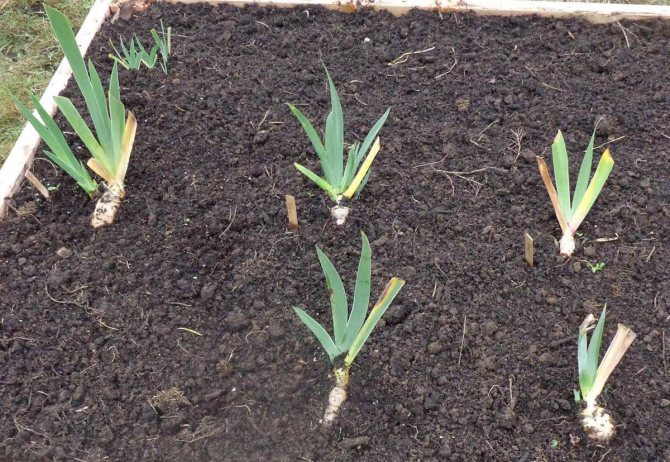

All irises love oily, loose soil with moderate acidity. To increase the alkaline properties, the soil is mixed with chalk, ash or lime. It is recommended to plant irises in spring after adding compost, potassium-phosphorus fertilizing.
Depending on the variety, the moisture content of the site is selected. Bearded irises need high-quality drainage, so they are planted on the slopes in fan-shaped groups. Moisture-loving swamp species feel great in partial shade, next to water bodies.
Before planting irises, the flower bed is carefully dug up, treated with fungicides that prevent the development of insects, as well as herbicides that reduce the activity of weeds. The landing pattern is simple:
- a hole is dug, in the center of which a small mound is formed;
- the rhizome is placed on a dais, the lateral roots are straightened on the sides;
- the hole is covered with earth, then covered with sand, slightly crushed;
- the central kidney does not deepen, remaining on the surface.
During planting, do not deeply deepen the rhizome, it should remain close enough to the ground. Planting bulbous varieties has no fundamental differences:
- before planting, the flower bed is spilled with potassium permanganate, a growth stimulator for rapid rooting;
- irises are buried in the ground by 3-4 cm;
- the total planting depth should not exceed 12 cm;
- the excavated soil is mixed with the top layer of garden soil, crushed coal or sand for drainage;
- double superphosphate is used as a top dressing;
- after planting, the ground is lightly tamped so that the bulbs do not appear on the surface;
- re-irrigation is carried out after 3 days.
Irises love soil that is fertilized but not heavy. Coarse sand, peat or compost are used to loosen the soil. Excessive deepening can also damage plant development.
Preparation
When choosing a place for permanent cultivation of irises, a site with good lighting is preferred. With a lack of light, plants develop poorly and the flowers acquire a pale shade. Protection from cold winds is important for irises. Therefore, flowers are planted along the fence.


All types of irises love fertile soil rich in nutrients. It is preferable that the soil structure is loose. For loosening, river sand is added to heavy soils for digging. Soil with a low amount of nutrients is enriched with potassium-phosphorus fertilizers and compost. It is forbidden to add fresh manure to the soil.
Preferred for irises (especially rhizome) soil with a neutral environment. Reduce soil acidity with ash, lime or chalk. These substances are introduced during digging.
What soil moisture do irises prefer? Each variety needs its own:
- Iris marsh and siberian, prefers high humidity. Loves to grow where it is damp: in partial shade near water bodies. These varieties of irises develop well in the lowlands along the buildings.
- Bearded iris likes moderate humidity. To ensure the outflow of melt and rainwater, fan plants are planted on the slopes. Bearded irises are a good decoration for an alpine slide.
The garden bed is fertilized and dug to a depth of 20-30 cm. During digging, the weeds are removed along with the roots and the lumps are broken. The earth should be light and loose. Mulch the bed with straw or sawdust to reduce the growth of weeds and also to retain moisture in the soil.
Top dressing of irises
Although any plant needs food, flowers need it more urgently. Active growth of green mass in spring, large flowers appearing in summer require systematic feeding. The first is carried out immediately after the snow cover disappears, the earth has partially dried out. In different regions, the first feeding will be carried out at different times, from about February to April.
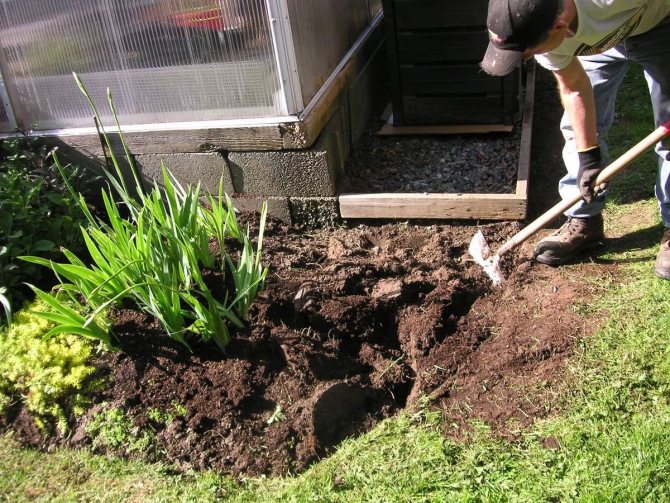

Top dressing of irises in spring and summer is intended to ensure lush flowering, as well as to prepare the plant for wintering. Moreover, in summer, fertilizers are applied only on too depleted soils.
In early spring, irises will actively increase their green mass, so the plants need nitrogen fertilizers.Magnesium and other trace elements will contribute to the synthesis of chlorophyll. In addition, add to the wet ground:
- potassium or ammonium nitrate;
- well rotted compost;
- complex mineral supplements.
Nitrogen supplements are applied at the rate of 1 tablespoon per bush. To make the fertilizer better assimilated, it is diluted in warm water, each plant is watered. If no shelter was used for wintering, the top dressing can be spread on the snow next to the bushes. It is strongly discouraged to spread fertilizers on dry soil. This can cause root burns. When using compost, top dressing is spread in a small layer under the leaves.
During the period of bud formation, flowering, irises need a lot of energy. An accelerated metabolism is provided by potassium-phosphorus supplements. Agrofoska contains both elements, therefore it is popular among gardeners.
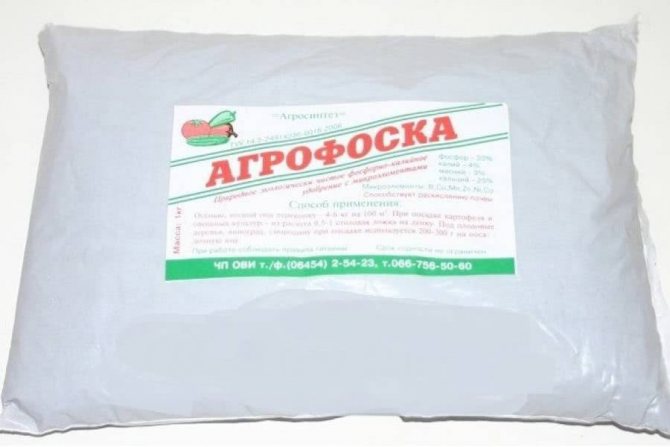

You can also mix the potassium-phosphorus cocktail yourself, using the materials available on the farm. A source of phosphorus can be products of bone meal processing - simple or double superphosphate. Such top dressing dissolves worse than nitrogen fertilizers, so it is recommended to apply them in shallow grooves.
Providing flowers with potassium will help:
- sylvinite;
- potassium sulfate;
- furnace ash.
Potassium salts are added at the rate of 1.5 tablespoons for each square meter of the flower bed. After incorporating the fertilizer, the soil is watered abundantly.
The last feeding is carried out after the flowers have completely wilted. An important rule for fertilization during this period is the complete absence of nitrogen. This is not advisable, since the autumn rains will wash it off the surface, carrying it into the deep layers of the soil. Also, the element causes active growth of greenery. This can lead to disruption of the natural rhythm, freezing out of the bush in winter.
Phosphorus and potassium, introduced closer to autumn, will provide immunity to irises before wintering, help to lay strong flower buds for the next season. When adding a few grams of sulfur to the fertilizer, it is easy to provide additional disinfection of the bush.
Preparing plants for winter
Approximately 3 weeks after the last flowers wither, the last irises are fed. Its main rule: no nitrogen. First, it will force the plants to resume leaf growth, as a result of which the bushes will not go to rest in time and may die from frost. Secondly, autumn rains will dissolve most of the nitrogen and carry it into the deep layers of the soil, and this is unprofitable.


Early autumn is the best time to enrich the soil under the irises with phosphorus and potassium, which will serve to lay the full flower buds of the next season and ensure the plant's immunity to the cold. The application rates are the same as in the spring.
If you plan to transplant irises, then a medium-sized handful of ash and 15-20 g of superphosphate are placed in each well.
Advice. When feeding in autumn, add 2-3 g of powdered sulfur to the fertilizer mixture - this is an effective prevention against bacterial and fungal infections of the rhizome.
Irises are among the plants that are better undernourished than over fertilized. Bring in nutrients based on the available soil fertility and the time of year - irises will respond to your care with beautiful flowering.
Transfer
Transplanting irises in the spring to another place is carried out immediately after the snow melts, the earth warms up. In this case, the iris bloom in most cases will be postponed to the next year. If the work was carried out in the autumn, then flowering could be enjoyed without interruption.


To divide an adult bush, you need:
- carefully remove the bush from the ground using a pitchfork;
- divide the rhizome so that each division is at least 10 cm, has leaves, a developed root system;
- leaves are trimmed to a height of 15 cm, roots - to a length of 5 cm;
- all sections are sprinkled with charcoal, dried.
If there is damage, all rotten areas are cut off, the remaining cuttings are disinfected with potassium permanganate.
Planting separated bushes is carried out in the same way as when planting rhizomes: a hill of earth is poured in the center of the dug hole, on which the main root is located, and the rest are straightened on the sides. The kidney should remain on the surface. The distance between the bushes should be at least 30 cm so that the plants can not be disturbed in the next few years. When planting, you can add a little saltpeter.
General information
Before planting irises on your site, you need to familiarize yourself with the peculiarities of their cultivation and care. Flowers are perennial plants belonging to the rhizome genus. To date, more than 700 species of this rainbow flower are presented to the attention of florists, impressive not only by the shape and size of the buds, but also by the variety of colors. In this case, the color can be not only monochromatic. One flower is colored in several tones, and also has unusual patterns on the lower petals.
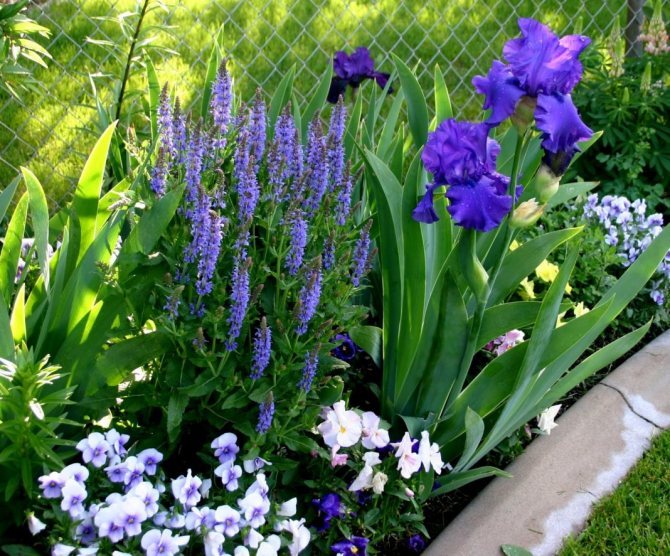

There are many different types of irises
Irises delight with their flowering from mid-May to early July, certain varieties also capture August. Some of them, with proper care, bloom a second time, around late August or early September. The distribution area of this culture is very wide, certain varieties can be seen even in the harsh northern climate. Already known not only the rhizome type of irises, but also the bulbous. It is almost impossible to distinguish them by their appearance.
On a note. Bulbous varieties require more care and attention, while rhizome types are famous for their unpretentiousness and undemanding care. They are frost-resistant and able to hibernate in the open field without shelter.
Spring iris care
In the spring-summer period, caring for irises is reduced to watering, loosening the soil, and removing wilted flowers. Plants do not need frequent watering. The bush needs moisture when the ground around it is very dry. Abundant watering will be required during flowering. However, it is better to transfer the water supply to the evening, when the sun is already low.
An important procedure is insecticide treatment, for which Malathion is perfect. It is carried out when new leaves reach 10 cm. If necessary, the procedure is repeated after 2 weeks. This helps protect the plant from insect pests.
For the prevention of rhizome decay, fungicides are used, for example, Fundazol. Processing is carried out 6 weeks before the appearance of flowers. In the spring and summer, the bushes should be examined. If signs of decay are found, an unpleasant odor appears, the affected part of the root is removed along with the ground around it, and the cut is thoroughly disinfected, sprinkled with ash.


In the second half of summer, irises fade, the need for watering is reduced. Excess moisture can lead to decay of the rhizome, so you should not be too diligent.
After the end of flowering, the peduncles are cut off. Yellowed leaves are also removed. It is not recommended to touch green shoots, since some varieties are able to please others with repeated flowering. In late autumn, it is recommended to trim the leaves, leaving up to 15 cm.
Usually, irises do not require close attention from gardeners. However, it is difficult to count on lush flowering without leaving.
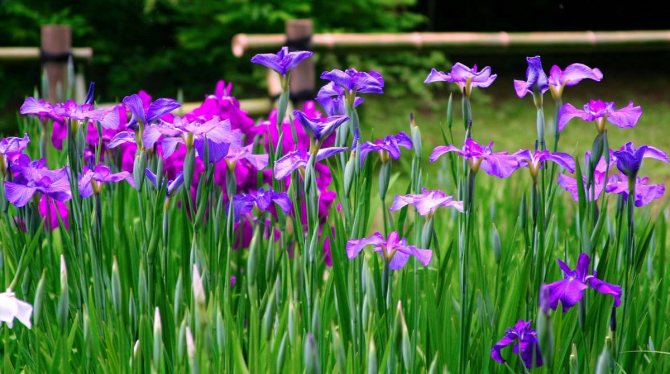

Professional advice
There is an opinion among flower growers that manure is the best fertilizer for most ornamental crops. However, it is absolutely not suitable for irises, since it can greatly inhibit growth and provoke rotting of the root system. After fertilization with manure, irises get sick, dry and throw off the foliage, and flowering becomes short and rare.Such feeding attracts various pests, therefore it is not recommended to use it. Experienced gardeners give the following tips for fertilizing irises:
- Use organic substances with great care, diluting them with water in a ratio of 1:20.
- It is preferable to apply dry dressing, ensuring the flowers are thoroughly watered.


- When feeding with compost from foliage, scatter it around the roots, followed by loosening the soil.
If flowering is delayed, but there is abundant growth of green mass, the problem may be in the excessive acidification of the garden area. In this case, it is necessary in the spring, even before flowering, to feed the irises with phosphorite flour, which will increase the pH of the soil to an optimal state.
Disembarkation dates


The specific dates of planting are chosen based on the climatic conditions of the region and weather conditions. After being placed in the ground, the iris needs 1.5 months for successful rooting. If you are late, the sudden onset of freezing temperatures can destroy the plant or lead to partial decay of the roots in winter.
Recommended landing dates by region:
| Region | Recommended timing |
| South | Mid to late October |
| Middle lane and Moscow region | Mid to late September |
| Leningrad region | First half of August |
| Siberia and the Urals | End of July - first decade of August |
Successful dates of the lunar calendar:
- 2-4, 11-12, 15-17 September;
- October 1, 4-6, 12-14, 19-21.

